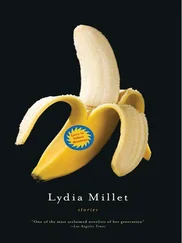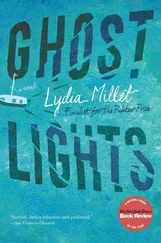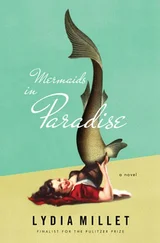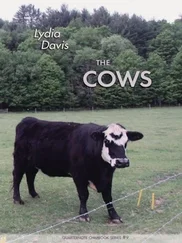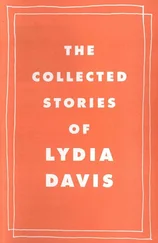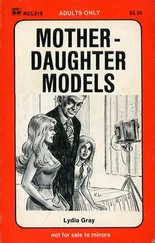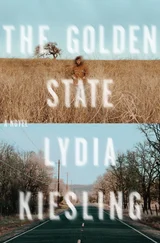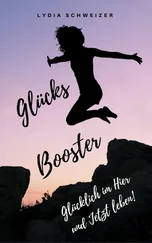“Jesus,” she said.
She moved forward. The next room was spacious, opened up to the dome above. A weak daylight filtered down and she could make out a wide staircase that circled up into a bristling dimness and still more deer heads, mounted on walls, sideboards, above doorways. Maybe not all deer, she thought: some were delicate and unfamiliar, striped or with elaborate curling horns — antelope or gazelle, maybe. There was a huge bull moose.
The ceilings were high and vaulted. Beneath the dead herds the place was startling in its elegance, though oddly decorated: purple curtains grayed by age and dust, crystal sconces on the walls, thick swoops of gold brocade — a magician’s stage, a goth bordello. She pulled the curtains open as she passed them, turned on lights and moved past the staircase, into a living room with more animals still. Here there were cats. Cheetahs or leopards maybe, she didn’t know the difference — not tigers, anyway. More than just heads, there were whole bodies posed leaping, posed stalking, streamlined with huge, round eyes and fur that seemed less their own than the coats of the rich black ovals on one, black rings with golden centers on another, the trappings of starlets. She looked closely into a face — the golden eyes, the fangs — then turned away.
The cats were captured forever in the seventies: stone fireplace, sunken lounge area, shag carpet and an L-shaped leather couch. Over the sofa was a lion rampant: its great mane flaring, it reared up, held its front paws in the air as if ready to box. It was either foolish or majestic. She gazed, trying to decide, but her eyes watered as she gazed. The murderer’s eyes watered.
It was the dust, no doubt. They said dust was composed of human epidermal cells, but in this house it was the dust of Africa, she thought. The dust of the flesh of the veldt, the aged, slowly dispersing brawn of the Serengeti.
In a cavernous dining room with dark ceilings, wild dogs and foxes lurked. Here some of the animals had labels, ranging from finely etched brass plaques to a kind of dark-red tape with raised white letters on it that she remembered from the seventies. She leaned in close to read them: a timber wolf in a cabinet with sliding glass doors, an American mink on a sideboard. The teeth were sharp. She hadn’t known minks had such sharp teeth. She kept on into the hallway with a shiver, where she found birds at her shoulders. Birds of prey — hawks, owls, eagles. An owl perched on a branch, an eagle spread its wings over a nest of twigs, a nest full of speckled eggs. A hallway led into a smaller room, a guest bedroom possibly or servant’s quarters, with Tiffany floor lamps shedding a green and yellow light. It was still birds, but they were not so fierce.
She felt slightly relieved: she’d run the gauntlet.
In the small bedroom there was a pink bird that must be a flamingo, standing with one leg lifted gracefully on a mirrored pool. She leaned down to touch the reeds — reeds of glassy plastic, glorified Easter-basket stuffing. Ducks, geese, pheasants. She barely noticed the furnishings, so abundant was the stuffed game. The specimens were labeled now: a line of small plump birds, a mother followed by three tiny stuffed chicks, bore a shiny plaque beneath that read COMMON QUAIL, OLD WORLD. She leaned in close to it and wondered if the chicks were real. How could you shoot something so small and put it together again?
Past the bird rooms she came into a large study, ceiling-high bookshelves all around but no ladder in sight. It had the other hallmarks of an old-fashioned library — wainscoting, reading lights with beaded strings to pull, end tables that gleamed with a cherry warmth beneath their patina of dust. An antique brown globe on a stand, crossed sabers over the mantelpiece. She was displeased to see she was back among animals with sharp teeth and claws. Bears protruded from the walls between shelves, fangs bared, black and brown bears of varying sizes. One stood upright and ferocious in the corner, beside a coat stand. Its head was huge and marked on the plaque were the words KODIAK, ALASKA.
She knew it was irrational but still she felt nervous, alone in the house with the predators. Their glass eyes followed her.
But that would be easy enough to set right, she thought, looking for the nearest door — she would escape the eyes by stepping outside, get out of the dark wood and fustiness and old fur and take a free, full breath. She would have the stuffed animals cleared out as soon as she could, hire some movers to get rid of them. Not wishing to insult her uncle’s memory, though, she couldn’t throw them in the garbage, she’d have to donate them somewhere — a third-string natural history museum, maybe, or a moth-eaten roadside attraction. She would redecorate the place from top to bottom. It would be an ambitious project, a difficult task — a task so large in scope that it could occupy her for as long as she wished it to.
Finally she found a door that led outside through a small utility room, in which she blundered around until she found the lightbulb cord. Daylight shone at the end but there were obstacles crowding in: she made her way around the handles of vacuum cleaners and mops in buckets, toolboxes and stands for sewing machines, piles of yellow ripple-edged phone books on metal shelves, a roll of chicken wire that snagged on her skirt. At last she stood in a shaft of natural light from a frosted window. Beneath it was a rusty bolt, which she struggled with till it slid open, her fingertips sore. When she stepped outside there were cobwebs on her face. A dot-sized red spider skittered up her arm. She brushed it off and blew the strands from her eyes.
The backyard was nothing like the front. It was overgrown in places, drying in others but still gorgeous, a sumptuous dereliction. There were ponds, filmed over and stagnant, shrubs with flowers, shrubs browning at the base. There were mounds of reedy grass, birdhouses, delicate hummingbird feeders of blown glass. There were trees of all kinds, tall conifers towering, and paths wended back into the undergrowth, half covered by leaves and pine needles. She felt she could barely walk without ruining her shoes but went out anyway, pushed along over the muddy litter on the paths till she was coolly shaded.
One of the ponds, outlined in smooth, rounded river rocks, was partly covered in lily pads and a scum of green algae so light it was almost luminescent. She thought she saw something move beneath the dark surface and stopped, holding her breath. A slow bubble burst on the water.
There was a fragrance in the garden, not just the smell of decay but also the pines, or spruce, or whatever they were, in the sun, and flowers — jasmine possibly, she thought, sweet and rich. At her elbow were the leaves of a huge rhododendron. She found a fruitless avocado tree, which she recognized because she’d had one in her backyard as a child. There was an orange tree, a lemon. She wondered how far back the garden went, kept walking even when the paths seemed to trail off through the bushy undergrowth. It look several minutes to reach the very back: a wall taller than she was, a pebbled wall. At the wall she turned back and gazed at where she’d come from. Her path wound through trees, between bushes, beneath limbs. The house was only visible in pieces through the complexities of green, its creamy white ramparts. But it stretched far to the right and the left; it did not seem to end.
True, it was not the ocean. She had planned for the ocean, when she considered a new home. The ocean was what she had foreseen. She had always been drawn to the sea, to the symbol of it more than what you could see — she thought of the untold depths, the deep blue mystery. But then, from the beach itself, the ocean could be flat and unknowable. The beach itself was mundane, compared to this — the beaches of L.A., at least, with the throwback hippies of Venice, the crowds of sweating tourists, bimbos rollerblading in headphones and bikinis.
Читать дальше


